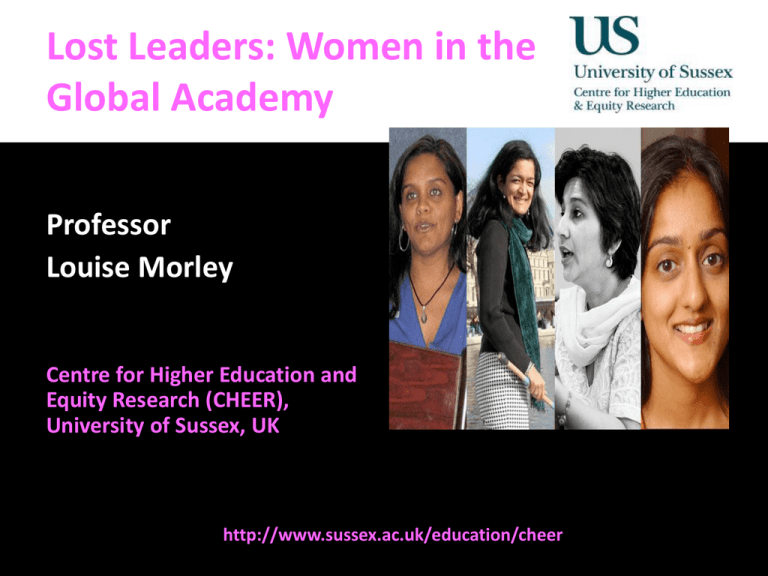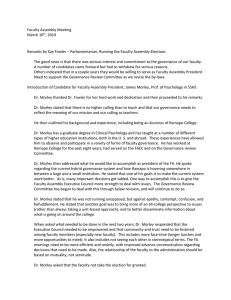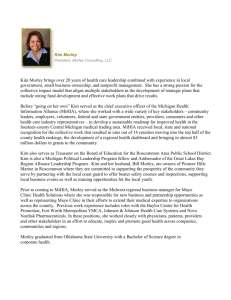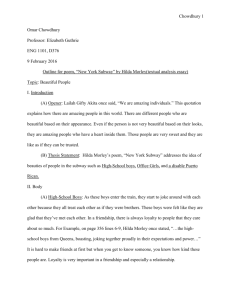Lost Leaders - Beyond The Glass Ceiling 2014
advertisement

LostDiversity, Leaders: Women in the Democratisation and Difference: Theories and Methodologies Global Academy Professor Louise Morley Centre for Higher Education and Equity Research (CHEER), University of Sussex, UK http://www.sussex.ac.uk/education/cheer Women Vice-Chancellors: Leading or Being Led? UK NOR INDIA JPN HK SRI LANKA 17% 31.8% 3% 2.3% 0% 21.4% Provocations: How/ Why • Has gender escaped the policy logic of the turbulent global academy? • Is women’s capital devalued/ misrecognised in the knowledge economy? • Is leadership legitimacy identified? • Do cultural scripts for leaders coalesce/collide with normative gender performances? • Do decision-making and informal practices lack transparency/ accountability/ reproduce privilege? • Are leadership narratives understood? Power, influence, privilege? Loss, sacrifice, conflict? Unliveable lives? Optics and Apparatus: Identifying Women Leaders • What is it that people don’t see? • Why don’t they see it? • What do current optics/ practices/ specifications reveal and obscure? Disqualified, Desiring or Dismissing Leadership: A Two-Way Gaze? How are women being seen e.g. as deficit men? How are women viewing leadership e.g. via the optic of neoliberalism/ austerity/ unliveable lives? Expanding the Theoretical Lexicon • Barad’s (2007) theory of intraaction: Leaders co-produced via power relations/ politics of difference. • Ahmed’s (2010) theory of happiness: Vertical career success = a happiness formula? • Berlant’s (2011) theory of cruel optimism: Women expect failure so do not put themselves forward. Evidence British Council Research South Asia • • • Rigorous Literature Review Interviews- 16 women and 7 men Afghanistan, Bangladesh, India, Pakistan and Sri Lanka. East Asia and MENA • 20 Questionnaires/ 3 Discussion Groups Australia, China, Egypt, Hong Kong, Indonesia, Japan, Jordan, Kuwait, Malaysia, Morocco, Pakistan, Palestine, the Philippines, Singapore, Thailand and Turkey (Morley, 2014). • What makes leadership attractive/unattractive to women? What enables/ supports women to enter leadership positions? Personal experiences of being enabled/ impeded from entering leadership? • • Why is Senior Leadership Unattractive to Women? • Neo-liberalism • Being ‘Other’ in male-dominated cultures. • Leadership v scholarship. • Disrupting the symbolic order. • Socio-cultural messages. • Navigating professional and domestic responsibilities. • Women lack capital (economic, political, social and symbolic) to redefine the requirements of the field. Women Reflexively Scanning Women Are Not/ Rarely • Identified, supported, encouraged and developed for leadership. • Achieving the most senior leadership positions in prestigious, national coeducational universities. • Personally/ collectively desiring senior leadership. • Attracted to labour intensity of competitive, audit cultures in the managerialised global academy. • Intelligible/ seen as leaders? Women Are • Constrained by socio-cultural messages. • Entering middle management. • Horizontally segregated. • Often located on career pathways that do not lead to senior positions. • Burdened with affective load: being ‘other’ in masculinist cultures navigating between professional and domestic responsibilities. Hearing leadership narratives as unliveable lives. Often perceiving leadership as loss. Demanding change. Manifesto for Change: Accountability, Transparency, Development and Data Equality as Quality - equality should be made a Key Performance Indicator (KPI) in quality audits, with data to be returned on percentage and location of women professors and leaders, percentage and location of undergraduate and postgraduate students and gender pay equality. Gender equity achievements should be included in international recognition and reputation for universities in league tables. Research Grants - funders should monitor the percentage of applications and awards made to women and to actively promote more women as principal investigators. The applications procedures should be reviewed to incorporate a more inclusive and diverse philosophy of achievement. Gender implications and impact should also be included in assessment criteria. Journals - Editorial Boards, and the appointment of editors, need more transparent selection processes, and policies on gender equality e.g. to keep the gender balance in contributions under review. Data - a global database on women and leadership in higher education should be established. Development - more investment needs to be made in mentorship and leadership development programmes for women and gender needs to be included in existing leadership development programmes. Mainstreaming - work cultures should be reviewed to ensure that diversity is mainstreamed into all organisational practices and procedures. Moving On: Global Initiatives • Develop: Policy Interventions • Collect: Gender disaggregated statistics • Ensure: Strategic management of gender mainstreaming • Initiate: Development programmes for women leaders in higher education • Review: Recruitment and selection procedures for leaders • Address: Socio-cultural challenges via: the curriculum e.g. Gender Studies gender sensitisation programmes. Critical Hope for Creating Transformative Spaces Invest in Women Equality is Quality Follow Up? • Morley, L. (I2014) Lost Leaders: Women in the Global Academy. Higher Education Research and Development, 33 (1) 111– 125. • Morley, L. (2013) The Rules of the Game: Women and the Leaderist Turn in Higher Education, Gender and Education. 25 (1) 116-131. • Morley, L. (2013) Women and Higher Education Leadership: Absences and Aspirations. Stimulus Paper for the Leadership Foundation for Higher Education. • Morley, L. (2013) International Trends in Women’s Leadership in Higher Education In, T. Gore, and Stiasny, M (eds) Going Global. London, Emerald Press.
![Lost Leaders: Women in the global academy - Istanbul, May 2014 [PPTX 454.02KB]](http://s2.studylib.net/store/data/015063383_1-42eb267dc0395ff642a30d9943f37a38-300x300.png)
![Lost Leaders: Women in the Global Academy [PPTX 453.94KB]](http://s2.studylib.net/store/data/015063384_1-2a7cc834e73fa099a2412a13eef30dbd-300x300.png)
![Lost Leaders: Women in the global academy [PPT 10.55MB]](http://s2.studylib.net/store/data/015063387_1-7bce35db5e0c2f5426de90c29a09b4b3-300x300.png)
![BERA 2013: Leading higher education differently: Desiring, dismissing or disqualifying women - Louise Morley [PPT 5.63MB]](http://s2.studylib.net/store/data/015063395_1-5e191a75dfbf575f10fafc15319947d9-300x300.png)
![Lost Leaders: Women in the global academy [PPT 12.31MB]](http://s2.studylib.net/store/data/015063394_1-705aef407e6af42872c492ce9864efc4-300x300.png)

![Lost Leaders: Women in the Global Academy [PPTX 1.89MB]](http://s2.studylib.net/store/data/015063385_1-ab78865b8230116cdf4a3cfa0811d729-300x300.png)
![Lost Leaders: Women in the global academy [PPTX 2.59MB]](http://s2.studylib.net/store/data/014998803_1-252f9c1d601e20ae1438f34c563b3f59-300x300.png)
![Lost Leaders: Women in the Global Academy [PPTX 1.70MB]](http://s2.studylib.net/store/data/014998809_1-e7761300a3f5a59fb4bd33b3f39907f0-300x300.png)
![Women in higher education leadership: Rejection, refusal, reluctance, re-visioning [PPTX 643.63KB]](http://s2.studylib.net/store/data/014998810_1-4198e6c23cde43f2a41845c735e08029-300x300.png)
![Lost Leaders: Women in the global academy [PPTX 2.22MB]](http://s3.studylib.net/store/data/009263777_1-be1374436717e20566e88e79cec67d26-300x300.png)
![Diversifying Higher Education Leadership [PPTX 21.11MB]](http://s2.studylib.net/store/data/014998801_1-697fa0ed698db3ffbac3745ff444b92d-300x300.png)



![Gender mainstreaming in higher education [PPTX 1.25MB]](http://s3.studylib.net/store/data/009261055_1-dfa19b70fcd91637c7a1dbd1bc939bd3-300x300.png)





